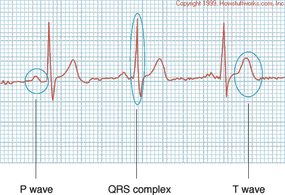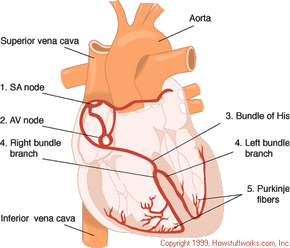The Body's Electrical System
Have you ever wondered what makes your heart beat? How does it do it automatically, every second of every minute of every hour of every day?
The answer lies in a special group of cells that have the ability to generate electrical activity on their own. These cells separate charged particles. Then they spontaneously leak certain charged particles into the cells. This produces electrical impuses in the pacemaker cells which spread over the heart, causing it to contract. These cells do this more than once per second to produce a normal heart beat of 72 beats per minute.
Advertisement
The natural pacemaker of the heart is called the sinoatrial node (SA node). It is located in the right atrium. The heart also contains specialized fibers that conduct the electrical impulse from the pacemaker (SA node) to the rest of the heart (see Figure 4).
The electrical impulse leaves the SA node (1) and travels to the right and left atria, causing them to contract together. This takes .04 seconds. There is now a natural delay to allow the atria to contract and the ventricles to fill up with blood. The electrical impulse has now traveled to the atrioventricular node (AV node) (2). The electrical impulse now goes to the Bundle of His (3), then it divides into the right and left bundle branches (4) where it rapidly spreads using Purkinje fibers (5) to the muscles of the right and left ventricle, causing them to contract at the same time.
Any of the electrical tissue in the heart has the ability to be a pacemaker. However, the SA node generates an electric impulse faster than the other tissue so it is normally in control. If the SA node should fail, the other parts of the electrical system can take over, although usually at a slower rate.
Although the pacemaker cells create the electrical impulse that causes the heart to beat, other nerves can change the rate at which the pacemaker cells fire and the how strongly the heart contracts. These nerves are part of the autonomic nervous system. The autonomic nervous system has two parts - The sympathetic nervous system and the parasympathetic nervous system. The sympathetic nerves increase the heart rate and increase the force of contraction. The parasympathetic nerves do the opposite.
All this activity produces electrical waves we can measure. The measurement is typically represented as a graph called an electrocardiogram (EKG). Here is an example of three heartbeats from an EKG (Figure 5):

Each part of the tracing has a lettered name:
- P wave - coincides with the spread of electrical activity over the atria and the beginning of its contraction.
- QRS complex - coincides with the spread of electrical activity over the ventricles and the beginning of its contraction.
- T wave - coincides with the recovery phase of the ventricles.
Electrical system abnormalities can range from minor premature beats (skipped beats) that do not require treatment, to slow or irregular beats that require an artificial pacemaker.
